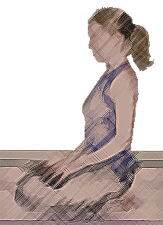 The second tattva of the Yin Yoga practice is stillness. Once we have found the edge, we settle into the pose. We wait without moving. This is our resolution, our commitment. No matter what urges arise in the mind, no matter what sensations arise in the body, we remain still.
The second tattva of the Yin Yoga practice is stillness. Once we have found the edge, we settle into the pose. We wait without moving. This is our resolution, our commitment. No matter what urges arise in the mind, no matter what sensations arise in the body, we remain still.
There are two exceptions to this advice. First, we move if we experience pain or if we are struggling to stay in the pose. And the second exception is – we move if the body has opened and is inviting us to go deeper. Unless these two reasons arise, we remain still. This is not a time to fix our pedicure, to look around and check out what the other students are wearing. This is the time for stillness.
Sarah Powers teaches that we seek three kinds of stillness:
- Stillness of the body like a majestic mountain
- Stillness of the breath like a calm mountain lake
- Stillness of the mind like the deep blue of the sky
Stillness of the body
The body becomes as still as a great mountain. A mountain is unaffected by the winds and dramas swirling around it. Clouds come and go, rains pelt and snows melt, but the mountain remains.
Stillness in the body means the muscles are inactive. Every time we move, we engage our muscles. The muscles naturally want to take any stretch in the body. One of the muscles’ jobs is to protect the joints. Only if we keep the muscles very quiet can we allow the effect of a deep stretch to sink into the joints. Fidgeting uses the muscles; fidgeting is a sign of a distracted mind.
When we move, we require energy. Energy is obtained by breathing. When we move, we affect the breath. Stillness of the body leads to stillness of the breath.
Stillness of the breath
Stillness here does not mean cessation. The breath becomes quiet, unlabored and gentle. Like the surface of a mountain lake, unruffled by wayward breezes, the breath is calm. A calm breath is regular and even, slow and deep, and natural, unforced.
Some students prefer a soft ujjayi breath [1]during their yin practice. This is perfectly okay, as long as it is soft. The harsher ujjayi found in the yang practices may create waves on the surface of the lake. A soft rhythmic sound of the breath will assist with calming the mind.
The breath need not be shallow or short, but it must be regular and unforced. You may try to extend the breath to four seconds, or longer, on each inhalation and exhalation. There may arise natural pauses between the inhalations and exhalations. This is fine, as long as it is unforced and natural. In the pauses between the breaths is the deepest stillness. Allowing the breath to be long, even, and deep is part of allowing this stillness of the breath to arise.
Once the breath has become quiet, the deepest stillness arises.
Stillness of the mind
The sky is always with us. Clouds may block our view, but we know with a certainty beyond faith that, behind the clouds, the deep blue sky is there. The sky is a metaphor for our true nature. We rarely see who or what we are, because there is so much drama in our lives, so many thoughts and distractions prevent us from seeing clearly what is really there. But on brief, wonderful occasions, the clouds momentarily part, and we get a glimpse of the blue sky behind the drama. As our practice deepens, these holes in the clouds come more frequently, and the gaps become larger. Eventually we see more and more of the sky for longer and longer periods.
This vision of our true nature is possible only when the clouds of thoughts have drifted away; stillness of the mind is required for this clarity. Stillness cannot be forced; the very act of trying to become still defeats itself. Stillness here must arise spontaneously of its own accord. We can, however, create the conditions for this arising.
To still the mind, the breath must be calm. To calm the breath, the body must be still. When these conditions have been met, deep awareness is possible. This state can be achieved only by commitment and dedication. Commit to stillness and allow whatever arises to be just what it is.
- — The ujjayi breath is obtained by slightly constricting the back of the throat – the same way is it slightly closed when you try to fog a mirror with your breath. With lips closed, ujjayi has an “ahhhh” sound on both the inhalation and exhalation. The sound may remind you of the wind in the trees, or the waves on the shore. A yang ujjayi may sound more like Darth Vader.
(Next: Holding for time )
